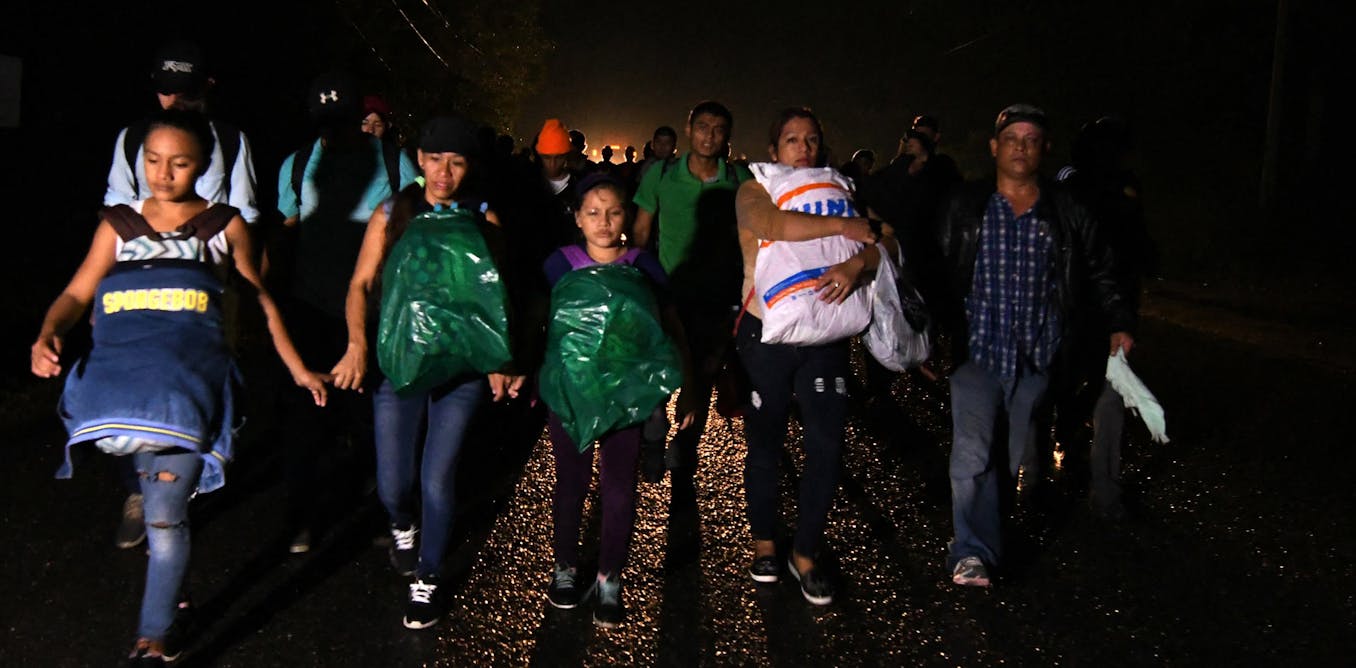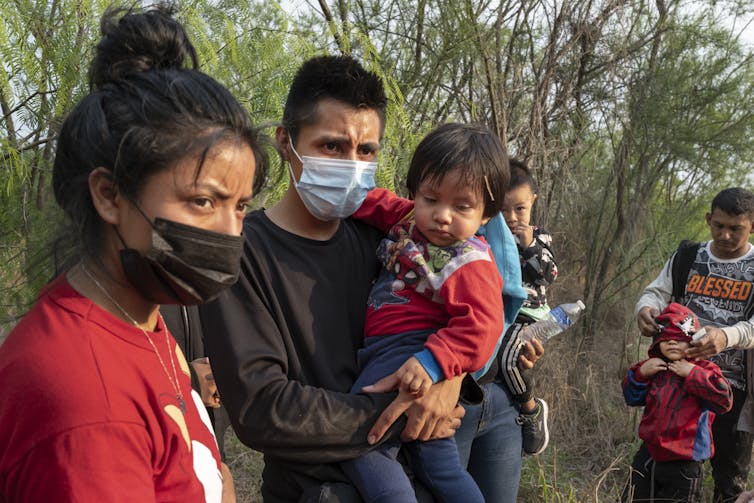Immigration policies don’t deter migrants from coming to the US — Title 42 and the border rules replacing it only make the process longer and more difficult


Politicians have been saying there’s an immigration crisis at the border for decades and have been trying to fix it for nearly as long. The rules have changed many times over the years – and they are about to change again as a pandemic-era set of restrictions expires May 11, 2023.
Before the COVID-19 pandemic, immigration into the U.S. at the border with Mexico was governed by a group of federal immigration laws and regulations, collectively known as Title 8. These laws, among other things, set the terms for the rapid deportation of people who enter the country illegally or are not eligible for asylum.
In March 2020, after COVID-19 hit, President Donald Trump declared a national public health emergency. That triggered a more restrictive set of rules under a decades-old, little used set of public health regulations known as Title 42. These regulations empowered Customs and Border Protection agents to both quickly expel migrants who entered the U.S. illegally and deny asylum seekers the right to enter the country as a way to stop the spread of a COVID 19.
As the public health emergency expires on May 11, the rules for prospective immigrants are changing again. The Title 8 rules are coming back into effect – and new measures from the Biden administration also will be in place. The administration’s goal is to stem the flow of an expected 13,000 migrants daily. But these new measures may exclude refugees facing real danger.
One new measure, for example, will deny asylum to people who arrive at the U.S. southern border without first applying for asylum online or in the country they passed through. And under Title 8, people who enter the country illegally could face a five-year ban from the U.S.
From my work as a scholar of migration studies, I believe the new set of rules may make some of the most vulnerable migrants even more vulnerable to economic and political exploitation and violence by delaying or denying them the protection of the U.S. under federal laws and international rules about asylum.
Delaying immigration and asylum
Research shows that the United States’ immigration policies have never deterred migrants from coming to the country; they have only made the immigration process longer and more difficult.
 Honduran immigrants wait for the U.S. Border Patrol after crossing the Rio Grande River from Mexico into Mission, Texas, on March 24, 2021. Michael Robinson Chavez/The Washington Post via Getty Images
Honduran immigrants wait for the U.S. Border Patrol after crossing the Rio Grande River from Mexico into Mission, Texas, on March 24, 2021. Michael Robinson Chavez/The Washington Post via Getty Images
In fact, asylum court backlogs have increased more than sevenfold over the past 10 years. There are more than 750,000 cases pending, with average wait times for a court date currently running over four years.
These figures do not account for the time it may take for migrants to get from their home countries to the Mexico-U.S. border, where they may also have to wait months or years to be allowed to cross. Parallel to immigration court backlogs are backlogs at the border, where the slow trickle of admissions to the U.S. of new asylum seekers, permitted now only via a glitchy smartphone app, have failed for years to keep up with new arrivals, seriously challenging Mexico’s capacity for housing them.
Humanizing deportation
Since 2016, I have coordinated a digital storytelling project called “Humanizing Deportation,” which has published personal narratives in audiovisual form from over 350 migrants. It is the world’s largest qualitative database on the human consequences of contemporary U.S. border and migration control policies.
Our research shows that as migration deterrence policies have multiplied and intensified over these past two presidential administrations, migration stories have become more complex and migrant journeys more arduous. One story from our archive shows how several of these policies have played out for a migrant family.
Our project is unable to verify all details of migrants’ stories, and what you read here is based on one family’s recollection of events.
A migrant from Honduras discusses the hardships, including deportation and kidnapping, he and his family faced as they traveled to the U.S. seeking asylum.
Deportations, childbirth and a kidnapping
A Honduran migrant who wishes to remain anonymous left his homeland initially in a migrant caravan in 2018. After crossing into the U.S., the migrant says that despite his insistence that he was fearful of being sent back and his refusal to sign a voluntary removal form, Border Patrol officers shouted obscenities at him and physically forced him to place a thumb print on the document, then deported him to Honduras.
The migrant set out again soon after that, this time with his pregnant wife and young son. Before getting far, they were detained by Mexican immigration authorities and later deported. But they left again, getting as far as Huixtla, Chiapas, in Mexico, where they had to stop so that his wife could give birth.
The family settled for a time in Monterrey, Nuevo León, but struggled to make a living there. They decided to pay a smuggler to accompany the wife and son to the Mexico-U.S. border, where in the summer of 2019 they crossed and were picked up by Border Patrol. Officers allowed the two to initiate their asylum process through the Migrant Protection Protocols program, a U.S. government program that returns migrants who arrived in the United States from Mexico by land back to Mexico while U.S. immigration proceedings are underway. Under its guidelines, they were sent back to Mexico to await a court date.
Human rights advocates criticized Migrant Protection Protocols because of dangers, such as extortion, kidnapping and rape that migrants face in Mexico. In this case, immediately after mother and son returned, they were kidnapped. Without the money to pay the ransom, they had to turn to friends and family, including the woman’s mother, who sold her house in Honduras to get them released.
Back in Monterrey, the husband, afraid to try applying for asylum after being deported but determined to reach the U.S., paid a smuggler to get him to Tennessee.
Meanwhile, his wife didn’t wish to stay in Monterrey. “I was really afraid – I didn’t go out because I felt they might kidnap me again,” she told us. So she retreated to southern Mexico with her son and baby daughter.
Working as an auto mechanic, the husband was able to earn enough money in Tennessee to pay most of what they owed the smugglers and their family.
Then, in 2021, when the Biden administration allowed migrants who had abandoned their Migrant Protection Protocols asylum applications to resume the process – but in the U.S. – the mother and children joined the husband in Tennessee. The following year, they moved to California, where as an immigrant family they feel more welcome than in Tennessee. Although the wife is still waiting for a court date, the family is hopeful that she and the children will be granted asylum. But she was thrilled to give birth recently to a baby boy in California.
“Because it’s more peaceful,” says the father, who is afraid to join his wife’s asylum claim because of his previous deportation. “We’ve heard that it’s where the immigrant community is most protected.”
Numerous policies over the past seven years have been enacted to deter migration, but many people have migrated anyway. They have been forced to navigate long, difficult, dangerous journeys and often traumatic migration processes that have endangered and complicated their lives.





